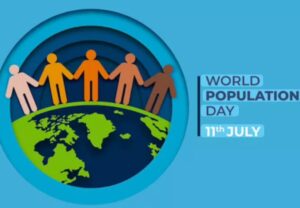World Population Day, 11 July: Know all facts.
World Population Day 📅 Observed: July 11 every year.
2025 Theme : “Empowering young people to create the families they want in a fair and hopeful world.”
What is World Population Day?
World Population Day is an annual observance established by the United Nations Development Programme (UNDP) in 1989.
It seeks to raise awareness about global population issues, including overpopulation, family planning, gender equality, poverty, maternal health, and human rights.
🏁 Origin and History of World Population Day
Inspired by “Five Billion Day”: The day commemorates July 11, 1987, when the world’s population reached 5 billion.
Established by UNDP:
In 1989, the Governing Council of the UNDP decided to mark the day annually.

First celebration of World Population Day:
In 1990, over 90 countries participated in observing the first World Population Day.
🎯 Purpose and Objectives of World Population Day
- Raise global awareness of population-related challenges.
- Promote sustainable development through informed family planning.
- Highlight reproductive health and access to medical care.
- Encourage gender equality and empowerment of women and girls.
- Address issues of aging population and demographic imbalance.
- Educate people about the impact of overpopulation on the environment and resources.
🧠 World Population Day Themes of Recent Years
Each year has a specific UN theme. Here are a few examples:
Year Theme
2024
“Leave no one behind: Count everyone.”
2023
“Unleashing the power of gender equality: Uplifting the voices of women and girls.”
2022
“A world of 8 billion: Towards a resilient future for all.”
2021
“Rights and choices are the answer: Whether baby boom or bust, the solution lies in prioritizing the reproductive health and rights of all people.”
📊 Current Global Population (As of 2024):
According to UN estimates, the world population is over 8.1 billion and continues to grow, though the growth rate is slowing in many regions.
🌐 Key Issues Highlighted
- Overpopulation: Strain on food, water, housing, and energy.
- Family Planning: Access to contraception and informed choices.
- Reproductive Health: Reducing maternal and infant mortality.
- Youth Empowerment: Access to education, employment, and sexual health information.
- Urbanization: Growth of megacities and pressure on infrastructure.
- Migration: Population shifts due to climate change, conflict, or economic issues.
- Aging Population: Increasing elderly demographics, especially in developed nations.
📣 How is World Population Day Observed?
- Seminars and discussions organized by NGOs, UN agencies, and governments.
- Campaigns on social media and public awareness drives.
- School and college events like essay contests, debates, and awareness rallies.
UNFPA (United Nations Population Fund) often leads global efforts and publishes reports.
📌 Important Facts
- More than 50% of the global population lives in just 7 countries.
- India overtook China in 2023 to become the most populous country.
- Sub-Saharan Africa has the highest fertility rate, whereas Europe has the lowest.
- Nearly 1 in 4 people on Earth is under the age of 15.
🇮🇳 India’s Context on World Population Day
📈 India’s Population Status
India became the world’s most populous country in 2023, overtaking China.
Current population (2024 est.): 1.44 billion
Accounts for ~17.8% of the world population
States like Uttar Pradesh, Bihar, Maharashtra, and West Bengal have the largest populations.
🔍 Key Population Issues in India
- Overpopulation and Density: India has only 2.4% of the world’s land but supports nearly 18% of the global population.
- Fertility Rate: The Total Fertility Rate (TFR) has dropped to 2.0, below the replacement level of 2.1.
- Gender Disparities in Family Planning: Access to contraception and reproductive healthcare is still unequal. Awareness is higher in urban areas than rural regions.
- Health Infrastructure Strain: Rapid population growth pressures India’s healthcare, sanitation, housing, and education systems.
- Urbanization and Migration: Unplanned migration to cities causes slums, pollution, and poor infrastructure
- Youth Bulge: India has the largest population of youth in the world.
Over 50% of Indians are below the age of 25, making it a demographic powerhouse if utilized properly.
📣 How India Observes World Population Day
Ministry of Health and Family Welfare (MoHFW) holds:
- Awareness drives
- Free health check-ups
- Camps on family planning
- Schools, NGOs, and community centers run
- Posters, debates, slogans, rallies, skits
- “Population Stabilization Fortnight” (July 11–24) is observed in many states.
Special campaigns by organizations like Population Foundation of India (PFI), UNFPA India, and Doctors Without Borders.
📊 Government Initiatives in India
Mission Parivar Vikas (2017):
Focus on high-fertility districts with incentives for spacing and small families.
National Population Policy (2000):
Aims to achieve population stabilization by 2045.
ASHA workers and community programs:
Promote contraceptives, maternal health, and institutional deliveries in rural areas.
Family Planning 2020 initiative (FP2020):
India is a global partner in achieving universal access to reproductive health services.
📌 Facts about India and Population
- Uttar Pradesh alone has more people than Brazil.
- India adds about 15–17 million people annually (net gain).
- Increasing life expectancy is also contributing to population rise.
- Education and women’s empowerment are directly linked to lowering fertility rates.
✅ Why World population Day Matters
World Population Day reminds us that population dynamics affect every aspect of human life—from education and healthcare to the environment and the economy.
It’s a call to action to ensure a better, more sustainable future for current and future generations.
